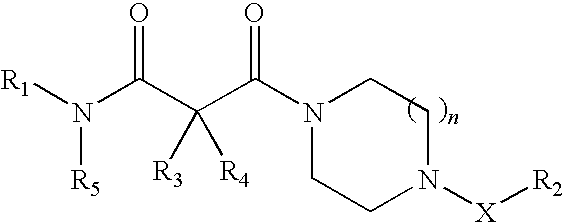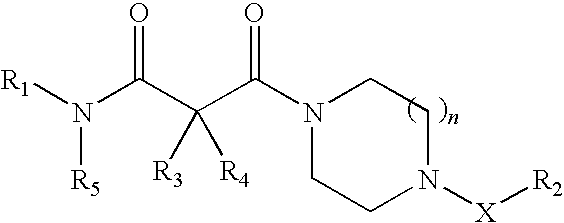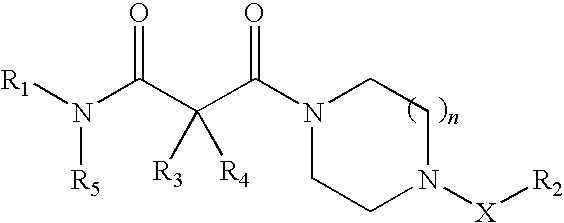Piperazine derivatives as inhibitors of stearoyl-CoA desaturase
a technology of stearoyl-coa desaturase and piperazine derivatives, which is applied in the direction of biocide, drug composition, metabolic syndrome, etc., can solve the problems of lack of effective treatment for metabolic syndrome in general and obesity in particular
- Summary
- Abstract
- Description
- Claims
- Application Information
AI Technical Summary
Benefits of technology
Problems solved by technology
Method used
Image
Examples
example 1
Synthesis of N-Biphenyl-4-yl-3-oxo-3-[4-(2-trifluoromethyl-benzoyl)-piperazin-1-yl]-propionamide
[0263]
[0264]HOBt (19 mg, 0.14 mmol) and DIPEA (0.017 mg, 0.14 mmol) were added to a stirred solution of N-biphenyl-4-yl-malonamic acid (40 mg, 0.14 mmol) in DMF (3 mL). The mixture was cooled to 10° C. and EDCI.HCl (40 mg, 0.2 mmol) followed by piperazin-1-yl-(2-trifluoromethyl-phenyl)-methanone hydrochloride (45 mg, 0.15 mmol) were added. The mixture was stirred at room temperature overnight, then diluted with water. The resulting precipitate was filtered and the residue was purified by column chromatography using silica gel 60-120 mesh and 90% ethyl acetate in hexane as eluant to afford 20 mg (30%) of N-biphenyl-4-yl-3-oxo-3-[4-(2-trifluoromethyl-benzoyl)-piperazin-1-yl]-propionamide. LCMS: 496.18 (M+1)+, 97.3%. 1H NMR: (CDCl3): δ 9.6 (d, 1H), 7.76 (d, 1H), 7.6 (m, 7H), 7.44 (t, 2H), 7.35 (t, 2H), 4.0 (m, 2H), 3.7 (m, 4H), 3.5 (m, 4H), 3.25 (m, 2H).
example 2
Synthesis of N-Biphenyl-4-yl-3-[4-(2,5-dichloro-benzoyl)-piperazin-1-yl]-3-oxo-propionamide
[0265]
[0266]HOBt (25 mg, 0.185 mmol) and DIPEA (22 mg, 0.175 mmol) were added to a stirred solution of N-biphenyl-4-yl-malonamic acid (50 mg, 0.175 mmol) in DMF (3 mL). The reaction mixture was cooled to 10° C. and EDCI.HCl (50 mg, 0.26 mmol) was added followed by the addition of (2,5-dichloro-phenyl)-piperazin-1-yl-methanone hydrochloride (55 mg, 0.187 mmol). The reaction mixture was stirred at room temperature overnight. Water was then added and the resulting precipitate was filtered and purified by column chromatography using silica gel 60-120 mesh and 50% ethyl acetate in hexane as eluant to afford 35 mg (41%) of N-biphenyl-4-yl-3-[4-(2,5-dichloro-benzoyl)-piperazin-1-yl]-3-oxo-propionamide. LCMS: 497.11 M+1)+, 95.5%. 1H NMR: (CDCl3): δ 9.6 (d, 1H), 7.64 (m, 2H), 7.58 (m, 4H), 7.44 (m, 3H), 7.38 (d, 2H), 7.32 (m, 2H), 3.95 (m, 2H), 3.8 (m, 1H), 3.75 (m, 4H), 3.65 (m, 1H), 3.52 (d, 3H), 3.3...
example 3
Synthesis of N-Biphenyl-4-yl-3-[4-(5-fluoro-2-trifluoromethyl-benzoyl)-piperazin-1-yl]-3-oxo-propionamide
[0267]
[0268]HOBt (25 mg, 0.185 mmol) and DIPEA (22 mg, 0.175 mmol) were added to a stirred solution of N-biphenyl-4-yl-malonamic acid (50 mg, 0.175 mmol) in DMF (3 mL). The reaction mixture was cooled to 10° C. and EDCI.HCl (50 mg, 0.26 mmol) followed by (2-trifluoromethyl-5-fluoro-phenyl)-piperazin-1-yl-methanone hydrochloride (60 mg, 0.193 mmol) were added. The reaction mixture was stirred at room temperature overnight. Water was then added and the resulting precipitate was filtered. The solid was purified by column chromatography using silica gel 60-120 mesh and 40% ethyl acetate in hexane as eluant to afford 34 mg (38%) of N-biphenyl-4-yl-3-[4-(5-fluoro-2-trifluoromethyl-benzoyl)-piperazin-1-yl]-3-oxo-propionamide. LCMS: 514.17M+1)+, 95.5%. 1H NMR: (CDCl3): δ 9.6 (d, 1H), 7.75 (m, 1H), 7.6 (m, 6H), 7.44 (t, 2H), 7.35 (t, 1H), 7.2 (m, 1H), 7.06 (m, 1H), 4.0 (m, 2H), 3.7 (m, 4H...
PUM
| Property | Measurement | Unit |
|---|---|---|
| w/w | aaaaa | aaaaa |
| w/w | aaaaa | aaaaa |
| temperature | aaaaa | aaaaa |
Abstract
Description
Claims
Application Information
 Login to View More
Login to View More - R&D
- Intellectual Property
- Life Sciences
- Materials
- Tech Scout
- Unparalleled Data Quality
- Higher Quality Content
- 60% Fewer Hallucinations
Browse by: Latest US Patents, China's latest patents, Technical Efficacy Thesaurus, Application Domain, Technology Topic, Popular Technical Reports.
© 2025 PatSnap. All rights reserved.Legal|Privacy policy|Modern Slavery Act Transparency Statement|Sitemap|About US| Contact US: help@patsnap.com



